#some of my favorites include the single-character ellipse: …
Explore tagged Tumblr posts
Text


#why do you need this many legs sir#toedscruel#woah holy shit i just looked outside and it's super dark out. i'm queuing this up at noon why is it so dark#lemme look#yeah it's. dark. there's a bunch of dark evil clouds in the sky lookin like it's gonna storm oh i just heard thunder yeah it's gonna storm#uh oh. good thing i'm queueing this guy up before the storm so my power doesn't go out. this happens frequently#anyway toedscruel. it's definitely an evolution of toedscool. it definitely looks like tentacruel#if it's a different pokémon why does it evolve into something so suspiciously similar. i can understand wigglet and wugtrio being#different pokémon. just based on how different they are from diglett and dugtrio. even though their names are a typo away#but this guy is. it. really should've just been a regional form‚ i think#unrelated‚ but on random occasions seemingly whenever someone new finds the blog and reads my tags#i'll occasionally get folks asking me how i type commas in the tags#the answer is that this character → ‚ ← is not a comma. it just looks identical to a comma because of tumblr's font#it's actually a lower quotation mark. so for a language that does ‚this kind’ of quotation marks#and i use it as a comma because i have a fancy linguist keyboard that can type all kinds of fancy symbols. and it's easily accessible#some of my favorites include the single-character ellipse: …#the degrees symbol: º and °#small A: ª#fractions: 1⁄2 2⁄3 1⁄4 etc#and obviously IPA symbols and various diacritics‚ so that i can type the word pokémon without having to copy-and-paste the E#currency symbols‚ too. £¢$§¥ euro is on here somewhere but i don't know where bc i don't use that one really#i just like being able to type things the way they're supposed to be. like it's 80º outside. the stopwatch costs 15¢ in the shop#and‚ of course‚ pokémon. it's the linguistics and computer 'tism combining together i think#it's storming harder now but i found the euro symbol: €#oh fuckin hell my lights just flickered. this is gonna be rough..!
61 notes
·
View notes
Text
That Albert Harebrayne Analysis I said I was gonna do months ago
So I’ve been doing a lot of thinking on my very unexpected favorite Great Ace Attorney character, Albert Harebrayne. To which I think I’ve found why this character in particular has managed to worm his way into my Top 3 Ace Attorney Characters alongside fan favorites Sebastian Debeste Eustace Winner and Miles Edgeworth. That being, he’s an absolute masterclass in making a supporting character. (This is about 30% analysis of Albert and Barok’s dynamic, 45% analysis of Albert himself, and 25% a secret third thing if you want some expectations.)
Warning: This gets long, I’m talking nearly 5k words long (4.8k. I’m pedantic). For the sake of your dash I recommend opening this in separate tab.
Albert’s Narrative Purpose
If I had to guess at Albert’s primary purpose in the narrative it would be that he exists to support Barok’s arc. Through his presence we see a kinder side to Barok, making him both more sympathetic to the audience, and adding believability to his eventual redemption arc.
However, the exact way Albert does this, while also having his own arc entirely separate from his connection to Barok, is what really makes his character. Albert exists to contrast Barok down to the simplest detail- from character design, to mannerisms, to their core traits and ideals.
Starting at the most superficial, in his key art Albert is drawn with flatter shading and cartoonier proportions compared to Barok’s dramatic shading and more realistic proportions. Albert is made up almost entirely of warm tones and light colors: blond hair, bright white lab coat, pink vest, tan slacks. Barok is in turn drawn primarily with dark colors and cool tones, made up of blacks, greys, and navy. There is also bonus of his purple-ish, blue-ish, grey-ish hair being complimentary, or in other words opposite, to Albert’s yellow blond. From the onset, without knowing anything about Albert’s character or that he has any connection to Barok, it’s clear that the two are inversions of one another.
Moving onto the character himself, Albert has a very distinctive way of speaking. He stutters, repeats himself, and goes off on rambling tangents near constantly. Comparatively, Barok speaks much more precisely. His frequent use of ellipses imply that he’s pausing to choose his words carefully. When he does falter it’s used sparingly- primarily for drama, and occasionally for comedic effect.
This characterization, Albert as flighty and Barok as controlled, continues in their animations. Albert can hardly stay still, and nearly every one of his animations includes constant movement. Either more subtly such as in his angry animation where he occasionally vibrates with fury, or overtly such as in his desperate pleading and excited mad scientist animations. Even in his neutral animation there’s the visual gag of him constantly pushing up his glasses as they fall down after every sentence. All this movement is punctuated by a shuffling sound effect that plays every time he changes poses, presumably trying to draw as much attention to it as possible. While Barok is no stranger to dramatic animations, what crushing glass chalices in his hands and drop kicking the prosecutor’s bench, the majority of Barok’s animations are more subtle. Outside of the courtroom he primarily closes his eyes, crosses his arms, turns his head, opens his eyes, lifts his chin, uncrosses his arms- you get the picture. His animations are extremely contained. Even taking into account his more dramatic courtroom animations, they’re all done with the same nonchalance, slow and flowing. The text box disappears, the story itself is brought to a halt, while it waits for Barok to finish his animations. A harsh contrast to Albert often switching animations multiple times during a single sentence.
These animations are used accentuate their respective main avenues for comedy. Albert as comically expressive, and Barok as comically serious. Most of Albert’s comedy is derived from how he approaches nearly ever situation at the same maximum emotional state. He recounts accidentally forgetting to return spare change to a waiter with the same level of regretful anguish, as he responds to being accused of murder. He even goes as far to say that he deserves to be hanged for that same murder as retribution for... forgetting to return the spare change. He gets so caught up in his own delight at the mere notion that his hypothesis was correct that he gladly incriminates himself on the witness stand. Barok, conversely, typically keeps at the same cynical indifference throughout any given trial. He slowly and deliberately tosses a wine bottle into the gallery behind himself only to claim that his hand slipped, enters the courtroom with his cloak drawn up like Dracula, harbors bats in his own office, and he does all of this without a hint of irony. Both use the same joke of having their emotional reactions be disproportionate to the situation, but reach that result from opposite directions.
This tone often transfers outside of their comedic moments, with Albert’s most common state being high-strung and emotional, while Barok’s is disinterest and apathy, with anger as really the only emotion he openly expresses for the majority of the games. Of course, both break from these states occasionally in order to signal relevant tonal shifts. Moments before Albert confesses to murder he’s resolutely calm and expressionless, warning the audience of what’s to come. The rare moments of Barok showing genuine sincerity, such as his overt gratitude towards Ryunosuke upon Albert’s acquittal, are used to represent major turning points for his character. For both, these “Out of Character” moments further ground them as three-dimensional, while still adhering to Ace Attorney’s exaggerated style of characterization.
Finally, their core traits and ideals. I find the most vital part of understanding Albert is his overwhelming kindness and optimism. Albert fully believes that Asman shares his dream in developing Instantaneous Kinesis, and protects the project not just for his own ego, but because he believes it’s what Asman would have wanted. He clearly states the respect he holds for Drebber as a scientist even after everyone’s assertion that he’s little more than a con-artist; even after it’s established that Drebber planned to frame him from the start. When Ryunosuke implores Albert to trust him and accept his defense, Albert responds by not only empathizing with him as someone who also spent time studying abroad, but by stating he believes a person’s origin has no effect on their ability- a sentiment Ryunosuke has scarcely heard for all his time in London. And of course, there is his fervent belief that Barok is working towards his best interests, despite the doubt voiced by Ryunosuke and Susato, and Barok’s seemingly contradictory behavior.
Personally, I find there is one scene in particular, and it’s follow-up, that best showcases Albert’s kindness. It starts during an intermission in the Defendant’s Lobby, before Albert’s invention has been officially declared a fraud but after Ryunosuke’s arguments have started leaning in that direction. Albert starts by accusing Ryunosuke of undermining him and attempting to discredit his hypothesis. Ryunosuke argues he promised to fight for Albert’s innocence above all else. He reminds Albert that, regardless of the validity of his hypothesis, a man died as consequence- that is what matters. Albert pauses for a moment, taking time to register Ryunosuke’s words, before urgently apologizing for blaming his failures on Ryunosuke. I find this scene best exemplifies Albert’s kindness as it’s not that he is a perfect sweetheart of a person all the time, but rather in the moments when he does mess up- in this case taking out his stress and frustration on an innocent party- he owns up to it the moment he realizes what he’s doing. Not only that, but he follows through on his apology. During the second investigation segment, which takes place the same day, Ryunosuke attempts to apologize for not protecting his invention. Albert refuses the apology instantly, reiterating that it’s his own fault, and that Ryunosuke shoulders no blame.
All of this stands in direct opposition to Barok. There is of course his prejudice, often manifested as his racism towards Ryunosuke, Susato, and Natsume, which also crosses into classism taking into account his treatment of Gina during 1-5. Even outside of that, Barok is wholly defined by his pessimism and distrust of others- his primary character flaw.
Going through this point by point is meant to illustrate that for every trait that Albert embodies, from the most superficial to the most intrinsic parts of his character, the inverse can be found in Barok. Albert exists to humanize Barok, but it’s not as simple as “Barok is kind towards someone, which was a previously unseen side of him,” it is specifically who he is kind to. The fact that Barok sees this person in direct opposition to himself, most importantly in the ways that they approach the world, and declares that person to be laudable, gives hope that Barok has the ability to change for the better. Albert could not have accomplished his role nearly as well had he simply been “Barok’s friend.” By existing in opposition to Barok from a characterization stand point this strengthens his support of Barok’s arc, further establishes the themes of trust integral to Great Ace Attorney’s greater narrative, and allows Albert to be a fully developed character in his own right.
Albert’s Character Arc
After discussing how Albert supports Barok’s arc, now I find it the best time to dissect his own. In between the chaos of 2-3, which is already packed to the brim with plot set-ups, ramifications, and character moments, Albert manages to have his own arc entirely separate from his connection to Barok.
Albert’s arc is centered around the revelation that the dream he was clinging to was ultimately a lie. The people who he trusted were planning to betray him from the start. The moment that was meant to be his dream coming to fruition literally blows up in his face, and what scarce success he finds to hold onto is revealed to be little more than stage magic.
There are two primary factors that lead to Albert’s actions and reactions throughout the case.
Albert genuinely trusted Asman and respected Drebber. He continues to respect Drebber even after the truth is revealed.
Albert cannot personally accept that the dream he spent so much time working towards might’ve been a failure.
The first point I alluded to while discussing Albert’s ideals. Repeatedly throughout the first half of the case he shows great admiration for Asman- he equates Asman visiting his lab to read his a paper to a visit from an angel. He states repeatedly that he must protect the invention that they made together for Asman’s sake. As far as Albert is concerned, Asman genuinely believed in him, and wanted to work alongside him to make Instantaneous Kinesis a reality. He devotes himself entirely to repaying Asman for his generosity; Asman’s ulterior motives, unbeknownst to him.
As for Drebber, the first showcase of Albert’s respect for him comes from the second investigation segment. The previous courtroom segment ended with Ryunosuke declaring that it’s very likely that Asman and/or Drebber were attempting to frame Albert, and two separate members of the jury discoursing on Drebber’s status as a swindler. What follows is Ryunosuke asking Albert if he really had no idea that Drebber was “Just an illusionist”. Albert refutes this by stating that Drebber isn’t just an illusionist. He clearly has a brilliant scientific mind, Albert is certain of that after only one conversation. Ryunosuke makes a comment on Drebber's abilities, which could be called disparaging in only the most harsh interpretation, and Albert still feels the need to correct it. Giving due respect to a man he currently believes is attempting to frame him for murder, as Susato reminds him. And Albert is correct in his assessment of Drebber. In fact, Drebber’s intelligence is a key factor in the case, but Albert would be more than justified in being a bit unkind to Drebber, considering the situation. Yet, he refuses to.
This point, his trust for Asman and Drebber, influences Albert’s action’s somewhat, but the second is the ultimate driving factor. At the end of the first pair of trial segments, following the reveal of Drebber’s true nature, Albert reflects on the recent events. He freely admits it was his own ego and fear that drove him to try to protect the invention. During the turning point when Albert confesses to murder, he considers that punishment preferable to the alternative. Because the alternative, is that he failed.
One line in particular I want to draw attention to he says towards the end of his monologue:
“I never questioned anything. I, I didn't want to question it.”
I feel this line re-contextualizes many of his actions during the trial. He insists, against his own innocence, that the experiment was a success. It was not simply foolish ignorance that led him to defend his hypothesis beyond logic itself; it was instinctive denial- conscious or otherwise.
Now in most Ace Attorney games, Great Ace Attorney included, The Truth is near sacred. many character arcs are centered around the pursuit and acceptance of the truth, never hiding from its uglier sides. It’s better to know the truth than live a lie. Albert is no different. He spends the first half of the case in denial because the truth is too harrowing for him to accept, until he reaches a point where he is forced to confront and accept it for the sake of his own life. By all means, with this revelation, his arc is over. The next step is for him to move forward, always push on despite the hardships, and pursue the glorious truth above all else.
But this is not the end of Albert’s arc. You see, that scene never addresses the root of his insecurity. Why was Albert so opposed to accepting the truth? Why did he go as far as falsely admitting to murder, which at this point is thoroughly established to be punished by death, over accepting the much simpler fact that his hypothesis was flawed and his experiment was sabotaged? He says it himself during his monologue: “I knew that if it was found to be nothing more than a trick […] my whole life would be over!”
The root is that Albert entirely conflates his own person-hood and worth with his success as a scientist. If his hypothesis is a success, then that means he, as a person, is a success. If his hypothesis is a failure, that means he, as a person, is a failure.
This is built up throughout the entirety of the case. When Ryunosuke first introduces himself as a lawyer, Albert launches to ask if he’s here to defend his hypothesis. On the surface, it’s just a simple introductory gag. This is the audience’s first encounter with Albert aside from his appearance in the opening cutscene, and the first interaction with him as an actual character. His whimsically goofy theme kicks in, his glasses fall down to reveal his unintimidating face. How silly, the absent-minded scientist assumes the defense attorney is here to defend his hypothesis and not himself. It’s the obvious joke to make, and it quickly establishes exactly what archetype Albert is meant to embody. But then it keeps happening.
When he pleads with Ryunosuke to trust him, that he would never murder someone, he says: “Do you believe me? Do you believe in my hypothesis?” While berating himself for unfairly taking his frustrations out on Ryunosuke, he says “I'm a disaster! Not just as a scientist, but as a human being!” When he gives his insight on Barok’s behavior, he says: “He believed in me this morning, you know. Barok did. He believed in my hypothesis.”
Nearly every time Albert references himself a mention of his hypothesis and career is not far behind, and vice-versa. As far as he is concerned, believing in him is believing in his hypothesis. Believing in his hypothesis is believing in him. They are inseparable. The line about Barok comes in the investigation segment after Albert accepts his experiment was a failure proving that, despite accepting the truth, he hasn’t worked through the insecurity that made him so terrified in the first place. He has accepted that his experiment was a failure, but he still believes his person-hood is connected to the success of his hypothesis.
All this comes to a head at the end of the case. Drebber admits to his crimes, and takes his opportunity to rebuke the “Addle-brained mock scientists” who “Don’t recognise the fact that they don’t have talent” and “end up chasing impossible dreams.”
Albert then takes the stand to accept his acquittal. He goes on to echo Drebber’s words, calling himself a selfish and self-centered fool for “believing that [he] could do whatever [he] set [his] mind to, despite [his] lack of talent.”
Despite it being proven many times over that Drebber only wanted to use him, despite Drebber’s disdain being entirely fueled by bitter spite, and despite Ryunosuke proclaiming that Albert’s only “crime” was his passion for his hypothesis and that he was entirely undeserving of Drebber’s ire, Albert still takes Drebber’s words to heart. Even after his betrayal, Albert still holds Drebber’s opinion as a scientist in high regard. Albert’s opinion of himself was already left in tatters due to his association of his worth with his success, but hearing scathing critique from a fellow scientist that he holds personal respect for was the last push he needed.
Following this, Barok refutes both Albert’s and Drebber’s words. He reassures Albert that he is not at all to blame for the events that unfolded, and applauds Albert’s passion and dedication to always pursuing his dreams.
Ultimately, Albert’s arc is centered around his own internal conflict of accepting his failures, and divorcing those failures from his worth. Alongside that, he continues to act as a support character to Barok’s arc. By allowing Barok to be the one to step in, and pick Albert back up when he’s at his lowest the audience sees a near unprecedented level of kindness from Barok. Which, of course, supports his redemption.
A few more points I’d like to make: Aside from Barok’s involvement in the final step of Albert’s arc, the rest of it is entirely devoid of his presence. While their friendship and dynamic is an extremely important aspect of Albert's character, having his arc focus on his own personal struggles allows him to exist as a character outside of his relationship to Barok. This strengthens his personality as an individual person, which ironically strengthens his relationship with Barok.
Furthermore, while his arc is entirely separate from their dynamic, it still manages to continue the theme of Albert existing in contrast to Barok.
When Albert finds himself betrayed by those he believed he could trust, his instinct is to blame himself. He was too foolish to see the signs that his dream was a failure from the start, and he was the one to naively hold onto the hope that anyone could ever honestly believe in him. If he had just given up from the start none of this would have happened. In Barok’s own backstory he was similarly betrayed by someone that he trusted. Barok’s response was to lash out, to claw for revenge and someone to blame. He continued by isolating himself in his grief, growing more distrustful each day, and going as far as to treat anyone who barely resembled the man that betrayed him with equal resentment.
Albert’s response to betrayal was too lose trust in himself; Barok’s response to betrayal was to lose trust in those around him. With this taken into account, it becomes clear why Barok must be the one to reassure Albert of his innocence. However, he does not suggest that Albert should be bitter and vengeful in response to betrayal, but rather only that he should not lose trust in himself- finding a middle ground between their two extremes. This serves to highlight the character growth Barok has gone through up to this point.
This, all of this, is what I meant by Albert being a masterclass of a supporting character. Every individual facet of him ties back into that all-encompassing narrative goal of acting as support for Barok’s arc, while also existing as an individual character in his own right. Despite existing to support another character, his own identity is not lost in that goal.
Arguably, Albert would have been fine without his arc. He would have been fine if his entire character centered around his dynamic with Barok. Again, if his role is to be a supporting character he could have been decently serviceable as simply Barok’s old friend who got himself in a bad situation, and who acts as an optimistic voice insisting that Barok really does care about him deep down. This would be proven by Barok’s actions before, during, and after the trial, Barok would seem just as sympathetic since he would still be going out of his way to help another person, and the end result would be nearly the same, if not slightly less interesting. And that’s the crux of it, Albert is a more interesting character than he would have been if he was only “Barok’s friend”. He doesn’t need to be, but he is, and by putting that extra care and time into his character the relatively simple story beat of “Antagonistic character shows kindness towards another person helping to spur their redemption arc,” becomes something that gives much greater insight to both characters involved.
Before breaking down Albert’s character like this I had less appreciation for Barok. I still enjoyed him greatly, he was a low-A on a bad day, but I did not enjoy him as much as the other main cast. After ruminating on this as extensively as I have, my opinion of Barok has soared. Breaking down Albert’s character and role on a narrative level directly led to me liking Barok more, and if that’s not fulfilling his role as a supporting character I don’t know what is.
My Thoughts and a Conclusion
You can consider this work finished. I’ve said many words and made my overall point: Albert is a well constructed character on a technical level. He is tightly written, with exactly the amount of screen time he needs to accomplish everything his character is used to do, and he accomplishes it exceedingly well, in my opinion.
However, there’s one last point I haven’t covered. I opened this piece declaring that Albert is my overall second favorite Ace Attorney character. In a franchise spanning over two decades with mountains of characters that’s high praise, so why him? There are countless other characters in Great Ace Attorney 2 alone that are written just as well if not better, and have an even stronger connection to the overall plot and themes. There are many characters that I respect from a writing stand point, and yet they still don’t reach my top ten, twenty, thirty, beyond. I could go on for hours combing through line by line, word by word pointing why I like this bit, or how I interpret this interaction, and it will never reach the real reason as to why I enjoy Albert, or any character for that matter, as much as I do.
It’s not something I can write into an analytical essay with textual sources to support my point, because it’s not analytical. I like Albert as a character not for any of the reasons I covered in the 3.5k words above, but because his character emotionally resonated with me. I did not do this analysis and suddenly realize I liked his character. I adored his character, and how I show appreciation for the media I love is breaking it down bit by bit to uncover all the moving parts.
The message of Albert’s arc amounts to “Failure does not define your worth as a person.” and that “Even if you try your hardest and fail that was not effort or time wasted, because trying at all is respectable in of itself,” and this is a message that deeply resonates with me. The next section will require me to get vaguely personal, so to put it simply I am a perfectionist. This manifests itself in nearly every facet of my life, but to give a lighter and more relevant example: This essay itself. I mentioned nearly seven months ago that I was working on an Albert Harebrayne Character Analysis. I have not been working on this essay for seven months. Instead, those seven months I’ve spent procrastinating; coming up with any excuse I could to not write this. My grasp on the character is not good enough. My analysis will be surface-level and shallow. I’ll just be rambling on about something that only matters to me, and is an annoyance to everyone else. I finally worked up the nerve to open a word document and just start typing only after it became undeniably clear that my mind wouldn’t rest until this was made. It all stems from the fear that whatever I make will be less than perfect. That whatever I do won’t be done to the quality it deserves. There’s more I could say, but with that alone I’m sure you can piece together why the message that your failures do not impact your worth as a person is one that I connect to.
However, it goes even further than that. Albert is not the only character or story with a message of that vein in Ace Attorney. There is a second aspect at play, which are the assumptions I made in regards to Albert’s character throughout the case- Assumptions born from my own insecurities. From the start, I assumed he was going to be wholly a joke character, pure comedic relief. That’s not to say I disregarded him, not at all. Absent-minded professors and mad scientists are some of my favorite archetypes, so at the very least I assumed I would enjoy his presence. I did not expect him to become my second favorite Ace Attorney character that is for certain.
My prediction for the direction the narrative would take Albert all came from that central idea: He was ultimately a joke. Obviously teleportation is impossible, and it seems like we’ll have to prove that in order to prove his innocence. Albert, meanwhile, is extremely invested in his experiment being declared a success. Alright, so that means we will inevitably prove the failures of his hypothesis, he’ll have a tragically comedic (emphasis on comedic) breakdown as is tradition, and that will be the end of his relevance. Point and laugh, and move on. Judging by the many words I’ve written previously we both know things did not go as I predicted.
I do think Albert’s arc is meant to subvert the audience’s expectations to some degree. He starts as a primarily comedic character. His introduction to the audience is a cutscene in which he’s voiced and animated like a Looney Tunes character. Most of the self-deprecation he voices is treated like just another quirk. With that said, I do not think my personal level of surprise was necessarily intended. It was arguably obliviousness on my part how long it took me to realize that Albert was being treated seriously, or at the very least, as a sympathetic character.
It was not the moment when Albert describes how the presentation at the exhibition was the finest moment of his career, and the resulting terror he felt at the prospect of it being ripped away- which is treated as purely tragic. It was not the moment when the culprit, the villain, claims that Albert is a fool and a fraud too talent-less to ever achieve anything. I’m honestly a bit ashamed to admit, but it was the last possible moment I could have realized: The exact second that Barok says that he is Laudable not Laughable. More bluntly, the exact second a character and the story itself looked me in the eye and said that he was not a joke. In retrospect, it became clear that the story was building towards that from the start.
Everyone, the storyteller themselves and each individual audience member, comes to a work of fiction with their own biases, with those biases effecting how they experience the story and their own individual interpretations. Due to my own insecurities I unconsciously projected my own fears onto the story, and expected those fears to be validated. And then they weren’t. Those fears were not only not validated, but outright rebuked by the story itself. Not only was I wrong in my belief- belief based on subconscious insecurity- that failure deserved derision, but the story states it deserves the opposite. Kindness. Sympathy.
That is what connected me to Albert’s character to the level of some major characters. An extremely personal set of circumstances leading the story to resonate with me in a way entirely unique. This is not a statement on the quality of Albert’s character, but rather a statement of quality on Ace Attorney as a franchise for putting so much effort and care into every character, no matter how minor.
I am certain that not every person holds Albert in as high regard as I do; As I am certain that they have their own personal favorites that they connect with to a similar degree; As I am certain that to me those favorites may be totally unremarkable. There is a beauty in that, I think.
To anyone who read this in its entirety, I hope you enjoyed it. Anyway, closing statement: Albert Harebrayne sure is one of the characters of all time, and instead of writing five thousand words about a random side character I managed to get too emotionally attached to, I could have simply summarized all my feelings with this image:

#I am never talking about this dork ever again (He says. Lying.)#ace attorney#tgaa#albert harebrayne#barok van zieks#yes this is an Albert Analysis however I do mention Barok a significant amount#They are intrinsically linked on a narrative level I fear
41 notes
·
View notes
Note
for the recent ask game: 1, 7, 19, 22, 36 :), 55, 73?
(sorry, these are just such interesting questions, i did try to limit myself i promise)
ahahahaaaa okay
1. Do you prefer writing one-shots or multi-chaptered fics?
truly i'd like to say that i enjoy writing multi-chaptered fics more. my ambition is grand! alas: my writing stamina is weak. i'm more prone to comfortably writing 500 words and cutting it off there. nobody resents this more than me.
so i suppose it's accurate to say i prefer writing oneshots and resent the fact that i prefer i writing oneshots.
7. How do you choose which POV to write from?
so for multi-POV works of fiction, i essentially switch when i get bored, or when i can't figure out where to go next. if i'm bored, then the next character should be more interesting; if i can't figure out where to go next, then i probably don't have a good grasp on at least one of the characters and need to get inside that character's head to do an examination.
for single POVs? it'll just be whoever I've decided will be the Main Character!!!
19. What is the most-used tag on your ao3?
...boringly enough, it's kim dokja. if you don't include characters, i'm afraid to say that everything is very, very even.
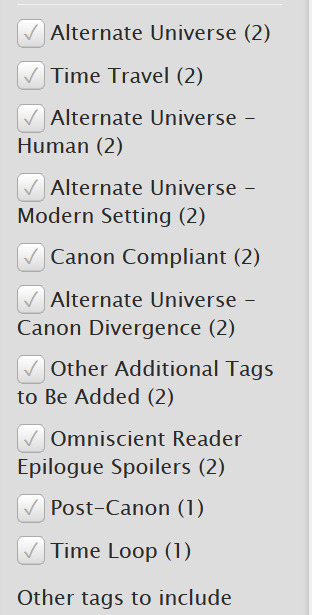
22. Are there certain types of writing you won’t do? (style, pov, genre, tropes, etc)
hmm. so i don't think i'll ever write anything that will require me to put a Dead Dove: Do Not Eat warning on it. any particular tropes themselves, i probably wouldn't shy away from at least implying, but it's incredibly unlikely that i would -- or even could! -- go far enough to say "YEAH I REALLY MEAN IT THERE'S A DEAD DOVE IN HERE", you know?
maybe the dove will be sleeping. maybe you will think the dove is dead but actually, surprise, it was alive the whole time. it is really hard for me to mean it enough to tell you this kind of thing, you know? i don't have the stomach for it.
36. How do you write kissing scenes?
I was WONDERING what the smiley face was for.
sometimes unromantically (i have described a kiss as tasting like spit more than once), but usually quite abstractly. there are some details thrown in - soft lips, warm mouths, hot tongues, this kind of thing. but am i describing what any of those are actually DOING? eh. not necessarily. does it work? who knows? not many of the kiss scenes i've written have actually made it out into the wild, i don't get much feedback on them.
sometimes i just go 'they kissed' and then i write about the panic that happens after that.
55. Of the characters you write for, which is your favorite? Has that choice been swayed at all by your followers/readers’ reactions to certain ones?
currently, it's my oc, yang haoran. i don't really have a favorite when it comes to fandom. for some reason, i haven't gotten quite the same joy out of breaking someone else's character in half, you know?
it's probably him because i definitely had some of y'all who enjoyed the story he's in and said some nice things about it. if i hadn't, it's unlikely i would have written him for long enough that i like him this much ahaha
73. What do you think makes your writing stand out from other works?
this is frankly a bit hard because i'm not terribly self aware about my own writing. i would have to say that often times, i don't let tension last long. in longer works, it's unlikely i can stay serious for very long; there's likely going to be a one-liner or joke that's popping up.
i'm also pretty fond of using repetition, often times in the same sentence, to smooth things out or to really hammer in a joke. i REALLY like using hyphens. I have a tendency to start paragraphs with ellipses (thanks, orv), and this certain way of structuring sentences (THANKS ORV) like so:
"This type of phrasing, I'm told it's incorrect", instead of "I'm told this type of phrasing is incorrect."
send me an ask!
6 notes
·
View notes
Text
SU fic cover... process
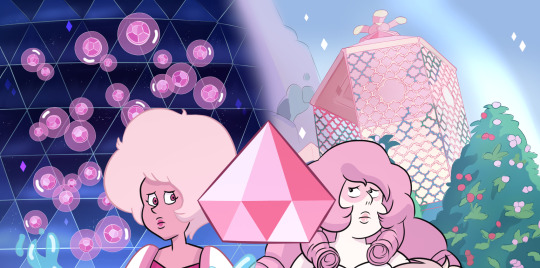
I wanted to do a lil’ write up about my process making the cover art for Crack the Paragon, since this is absolutely the most involved piece of art I’ve ever produced. I’ve spent a month off and on working on this hummer, and at least 50 straight hours, so I’m honestly mega proud with how this came out! As an artist though, I personally find it very valuable seeing other people’s process, their messy WIPs and sketches, all of that... so that’s what I’m gonna do here.
____
So all of this started as a humble little work doodle.
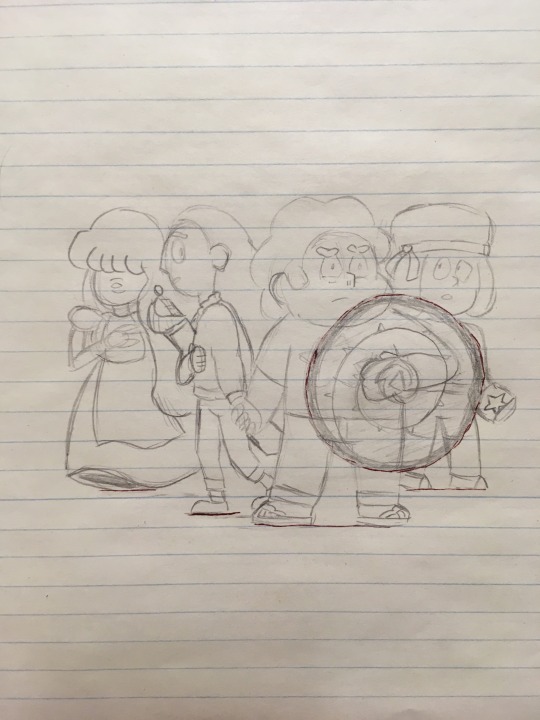
...that got really out of control. Mind you, I totally forgot which way Pink Diamond’s gem faced, apparently. Whoops! Dumb mistakes.
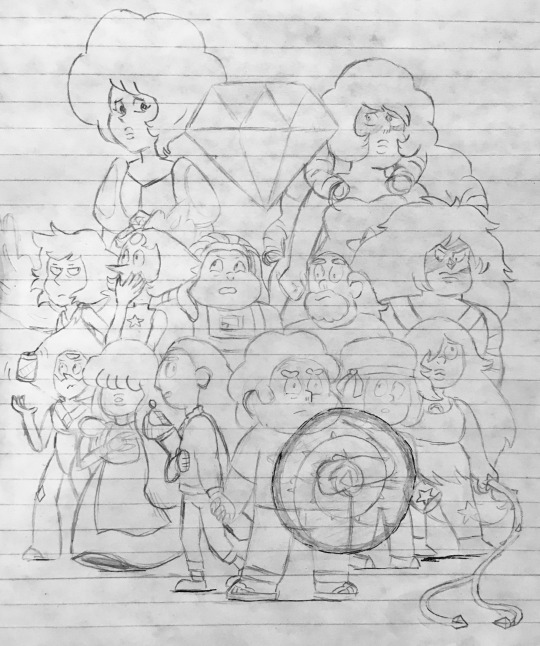
But upon getting home I thought the overall composition of this was a pretty cool idea, so I decided to try and make something out of it.
And thus begins the absolute chaos...
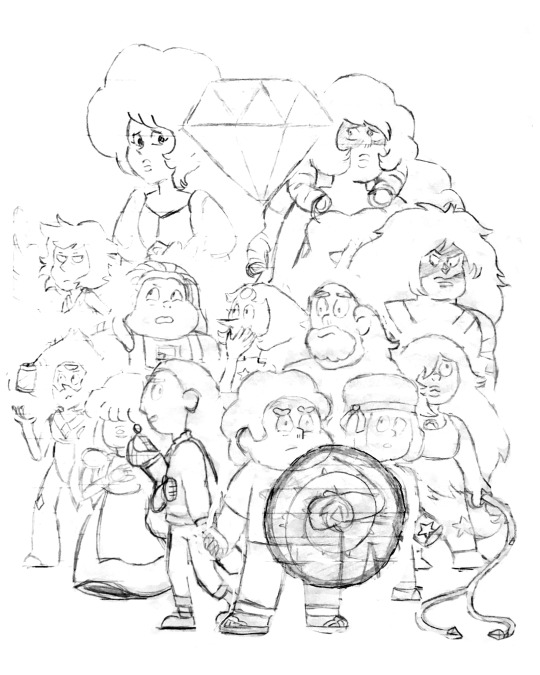
I legit threw the actual sketch photo onto Clip Studio Paint and edited it so the sketch stood out more... and then picked up individual characters and moved them around/resized them as I saw fit. By this point, all of the characters are in their rightful places. (I’m still a derp on that diamond, though. RIP.
And then...
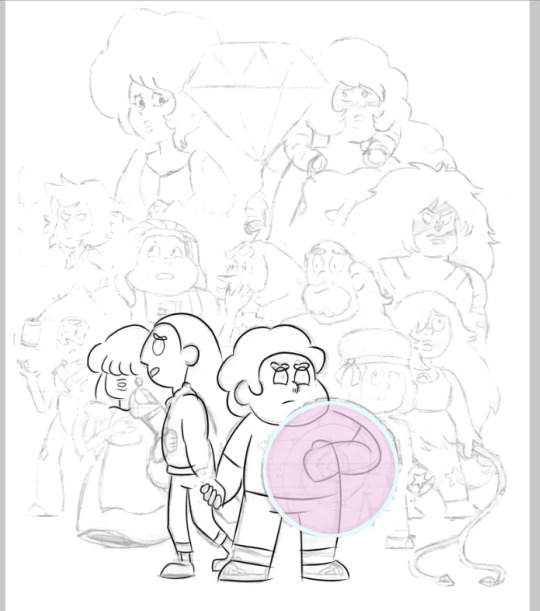
Oh god, the line art on this sucker pretty much killed me off. Line art alone took me a good 30 hours. The one thing I’m very glad I decided to do, however, was making Steven’s shield from transparent circles with the ellipse and fill tool. I don’t think I would’ve survived making a near perfect circle with the vector tools. Artists have limits, after all. XD
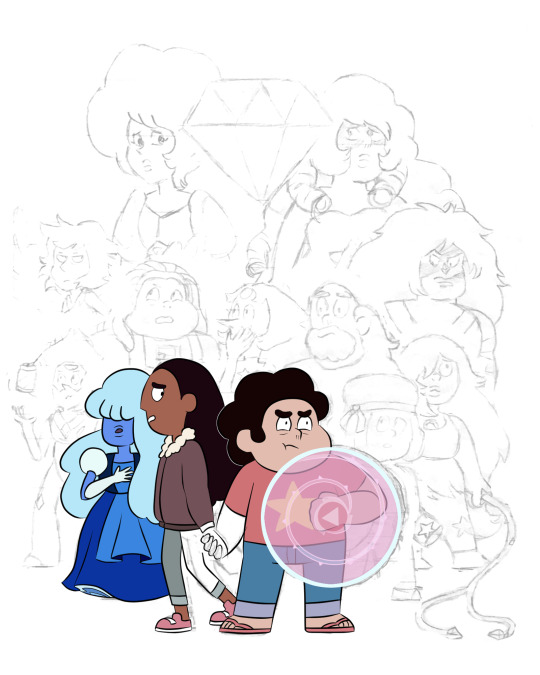
And we’re off to the races! I placated my need for color early on by doing flats as I finished each character. I drew all of the line art on one layer, but each character had a separate layer for flats. This made it far easier when I finally got around to shading. (The very last thing I did.) At this point I hadn’t figured out Connie’s sword yet, or Sapphire’s hair. Sapphire is probably the hardest Gem to draw for me. Steven’s shield is done though, which is nice.
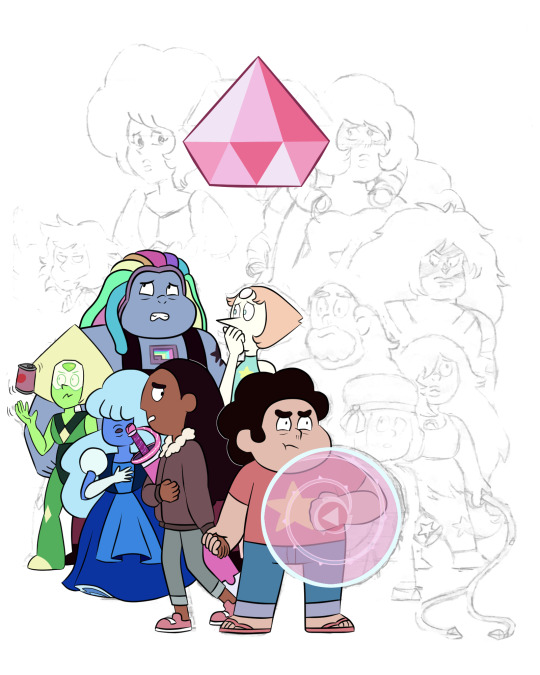
There we go! Finally, the diamond’s oriented the right way! Bismuth’s hair is probably my favorite to draw- I love her hhhhhhh! ! !!!
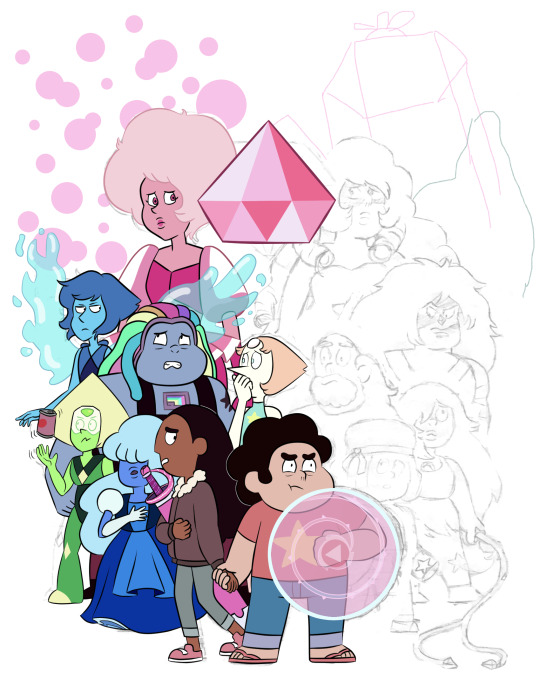
Ah, and here’s where I decided to make things ten times more difficult for myself- by adding background details! I must say though, I’m still very happy with how Lapis’ wings came out here. I love drawing transparent elements, they’re some of my favorite. That’s why I always make Steven’s shield obviously transparent.
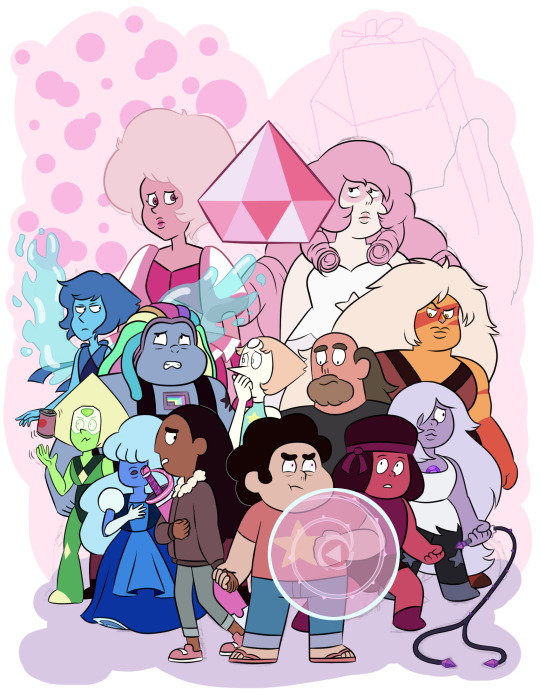
All character line art/flats complete!! Finally said “what the hell” and just gave Steven diamond eyes like my heart told me too. This directly coincided with my decision to include that in the fic, lmao.
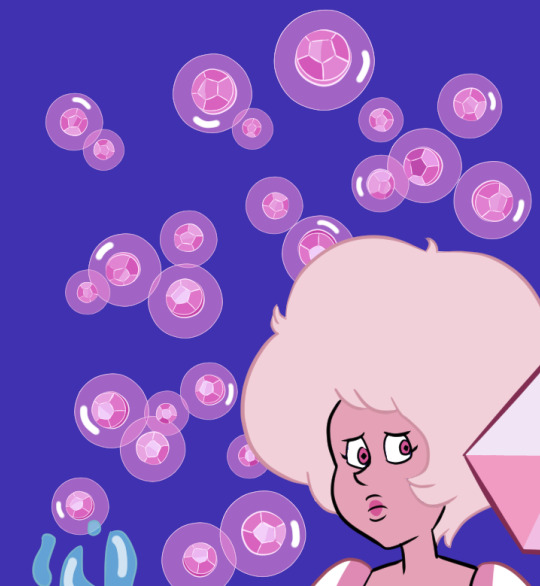
These Rose Quartz gems were really tricky and time consuming, geeze. I’m not so insane that I would draw every single one of them by hand, though- so I just drew three different angles and then copy/pasted them around. I did color them all individually, however. I have regrets, folks. My wrist burned that day. Still, I’m happy with the effect so I can’t really complain.
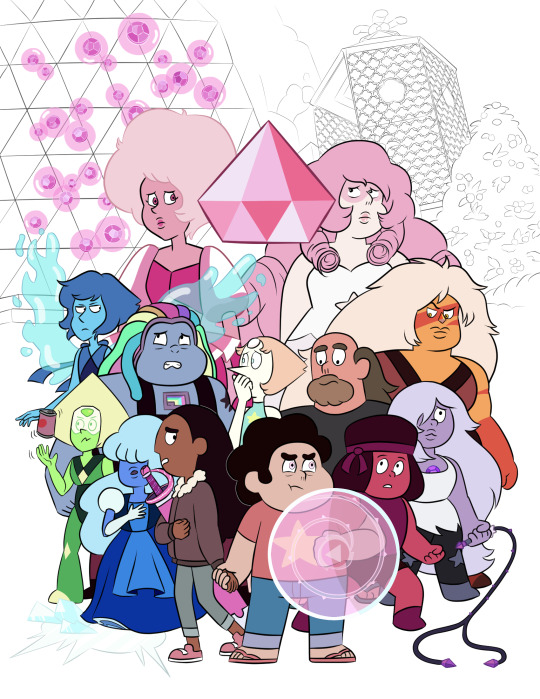
Line art for the background! Also, Sapphire has ice at her feet now. I really want to explore that ability of her more in the fic proper, like as a weapon...
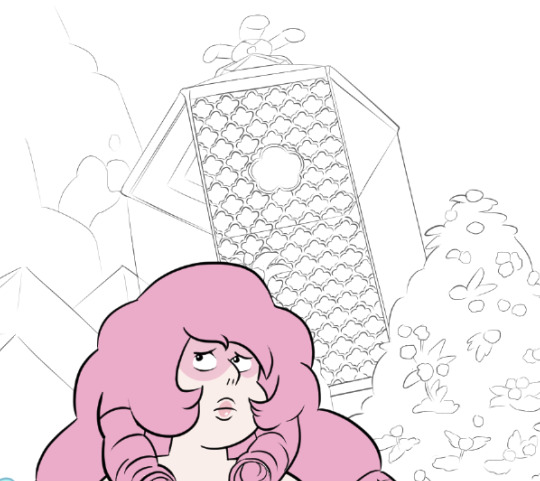
A close up of some unfinished palanquin line art... I heavily referenced canon images, but yes, I drew the actual line art completely freehand. It was hell, but so worth it in the end. Big kudos to the background artists for this ep, honestly... the setting is so beautiful :OO
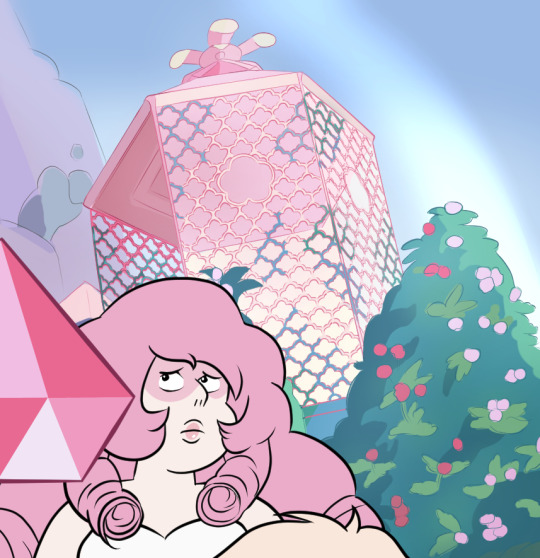
A close up of this background colored!
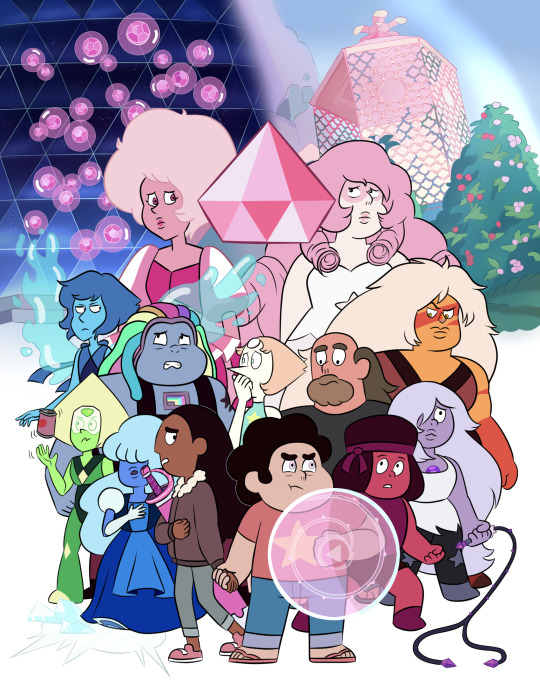
We’re almost done!! :DD Just the bottom of the background, and shading! I have bizarrely specific memories of listening to the ep of the SU podcast with Estelle while coloring the moon base scenery, oddly enough.
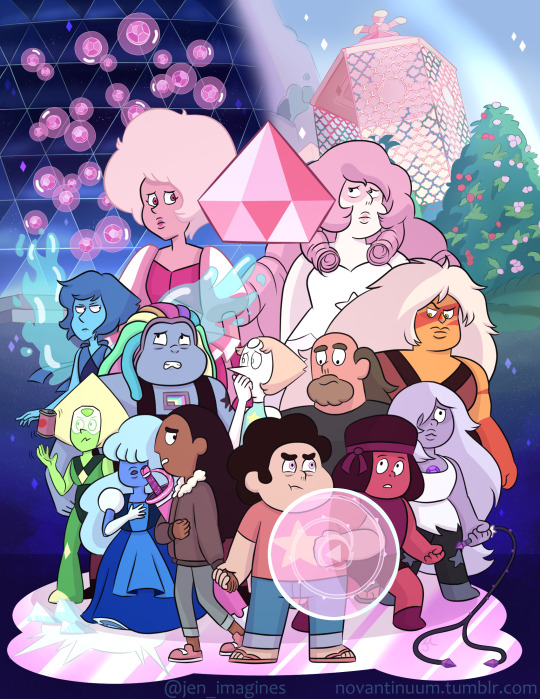
Aaaaand complete!! Along with the aforementioned bits, I also scattered some diamonds among the artwork.
For some fun random tidbits about how this artwork relates to my fic, both the moon base and palanquin settings have great importance to the overall arc. Jasper is there because I’m giving her the beginnings of a redemption arc. Ruby and Sapphire are separate for the time being, so no Garnet. (Although she is still together at the beginning of my fic- still haven’t quite reached that moment yet.) After he reforms, Steven’s eyes flare pink/with diamond pupils whenever he uses his Gem born ability.
And lastly, a rando detail about the expressions within this piece...
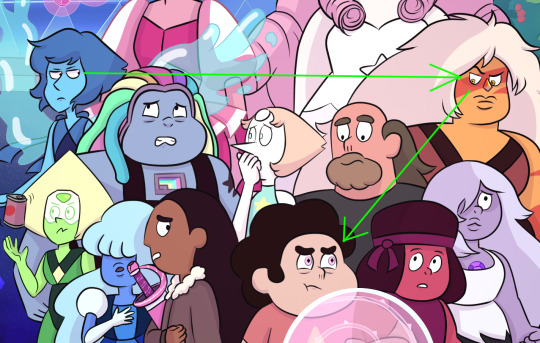
Lapis is glaring at Jasper, but Jasper is peering at Steven. That pretty much sums up both of their characters in this, ahahah.
16 notes
·
View notes
Text
Editing Advice Part 4: Copyediting
Now that you have checked your WIP for continuity, addressed every plot hole, and finished all rewrites, it's time to put on the final touches by copyediting!
Now, just to be clear, the term "copyediting" usually refers to when an editor, not the writer, reads the manuscript looking for errors, and it actually does include a lot of continuity editing and fact checking. But this series is for writers editing their own work before another soul reads it (regardless of if the work will then be self-published or sent out to agents and editors). It is my belief that, for a writer, continuity editing should come long before the final stage of the editing process. Thus, for our purposes, I'm going to use "copyediting" to refer to correcting errors in grammar, spelling, punctuation, and other such things.
Obviously, this involves going through your manuscript with a fine-toothed comb, on the lookout for misspellings and typos. However, there are a few items to especially watch for, roughly broken down into the categories of spelling; grammar, usage, and style; and punctuation, spacing, and everything else.
Spelling
Spelling of made-up or unusual words: If you write fantasy or sci-fi, odds are you're using at least a few words that don't exist in the regular lexicon. Make sure you use consistent spelling for these. This is especially true for different forms of said words. For example, I chose to spell "Lesse" in Lesse's Moor with and "e" at the end, which is easy to remember. Yet, when spelling the adjectival form of that word, I used either an "e" or "a": Lesserian and Lessarian. I had to choose one to use throughout. This goes for non-made-up words as well. "Empyreal" of the Empyreal Palace is a real word (it means celestial), but it's not like I've known how to spell it from my youth, so I still had to double check it every time I came across it to make sure it was spelled correctly.
British vs American spelling: If you spend a lot of time reading books from across the pond, you might have picked up some foreign spellings. As a child, I would always spell "gray" as "grey", because I liked it better, and to this day, that spelling sneaks into my writing from time to time. There are many such words in the English language that you should watch out for.
Hyphens: Make sure that you know which words are hyphenated, and that they are always hyphenated in your manuscript. Pay attention to height and ages: "six-foot tall", "four-year-old" and so on. Keep consistent for made-up words as well. Will you use "mechano-magical" or "mechanomagical"? Whichever you choose, you have to use that spelling every time.
Homophones and similar words: You might think that this is dumb to mention, since you, of course, know the difference between all the homophones in the world, but that's irrelevant. I know the difference too, yet I mix them up all the time in my writing. Some people picture the spellings of words even as they speak, and I am not one of them. I know the difference between "their", "they're", and "there" like the back of my hand; I still write the wrong one about a third of the time. Why? Because when I write, I'm picturing how the words sound and, moreover, how the scene looks, not how the text will appear on the page. That's what copyediting is for. You can Google lists of commonly misspelled or mixed-up words, or write down your own list if you have certain words you personally get confused.
Grammar, Usage and Style
Subject-verb agreement: By the time you're at this stage of editing, your manuscript is likely a Frankenstein's monster of sewn-together old drafts, and that tends to lead to some weird grammar. Make sure your subjects and verbs agree. That means that if the subject is plural—they, policemen, the dragons, or whatever—the verb has to be one you use on plurals—were, know, have eaten. If the subject is singular—he, a policeman, the dragon—the verbs similarly have to match—was, knows, has eaten. If you're not too keen on grammar, read it out loud and see if it sounds right; even if you don't know all the proper grammatical phraseology, you know English and you'll be able to pick up on errors that you hear.
Writing out numbers or not: Generally speaking, for narrative prose, you should write out the numbers zero through one hundred. For larger numbers, 101 to infinity, you can use numerals, but some guides suggest that numbers ending in two or more zeros should also be written out: two hundred, five million, etc. But I think you can get away with writing out larger numbers as well, like three hundred seventy-three; it looks nicer to me. Whatever you choose to do with larger numbers, stay consistent. Special numbers like years and addresses, however, should be written in numerals: 221 B. Baker Street, 1984, etc.
Capitalization of titles of people: Obviously, if the the title comes right before the persons name, and is thus part of their name, it's capitalized: Queen Delilah, Doctor Mario, Professor Moriarty, President Coolidge. But what about when the title is by itself? Well, it depends on how you're using it. If the title is used to address the person, it's capitalized: "You saved his life, Doctor!" or "Well, Professor, it looks like your theory was wrong." Obviously special title have special addresses which are obviously capitalized: Your Majesty, Mr. President, etc. If, on the other hand, you are talking about the person, or the office in general, it's not (usually) capitalized: "The professor is getting on my nerves!", "That doctor is a quack", "The president has to be an American citizen". However, for certain fancier offices, if you are talking about a particular holder of that office, you do capitalize it. Now, I found a few competing sources on this, but from what I could figure, the only titles that work this way are Pope, King, Queen. Again, you have to be referring to a very specific person to do this: "The Queen has been slain!" "The Pope blessed the travelers". Some sources also said this could be done for the president's of countries, but other said not to, so... I guess pick which way you'll do it an stay consistent.
Punctuation, Spacing, and Everything Else
Extra spaces: Get rid of 'em. This included two spaces after a period (for us old people who learned that that was the correct way to type!) as well as space at the end of paragraphs, between two words, and so on.
Missing punctuation: Don't forget commas after opening phrases like "Well, you see..." or "Of course, I'd never say that," or when separating a name when being addressed: "Are you ok, Constance?". Double check that every paragraph has a period or closing quotation marks; somehow, these seem to disappear on me and I've never figured out why.
Smart quotes, … vs ..., and m-dashes: This is almost getting into formatting territory, but I'm going to include it here anyway. Depending on what word processor you use to write your WIP, there might be some differences in how certain characters are automatically formatted. For example, some programs will turn quotation marks ( " " ) into smart quotes, i.e., one that wrap toward the text and have different opening and closing characters ( “ ” ). Something similar happens to ellipses, which may be typed as three periods (...) but turned into a single character (…). Finally, there is the m-dash, that long dash used in a way similar to a colon. When you type it by itself, it typically looks like two dashes (--), but if you type a letter, then two dashes, then another letter with no spaces between, it turns into a single character (—). I'm in favor of all of these automatic changes, as they look nicer, but depending on where you typed what part of my WIP, they don't always happen. It's a good idea to go though your manuscript and add them in, or set your word processor to change them automatically.
Personal foibles: Finally, know thyself. Are there weird mistakes that you always tend to make? I myself tend not to use question marks (they are a silly punctuation mark and ought not exist!). I have to be careful to check that all of my questions are, in fact, marked as such. Maybe you tend to spell one particular word incorrectly, or are really bad at using commas. Know your weaknesses and make an effort to fix them while writing and catch them while editing.
Tips to Make Life a Little Easier
The greatest tip I can give you is to embrace your Find and Find/Change or Find/Replace functions of your word processor. You'll find these in your edit menu.
Find should be used to check homophones and commonly misspelled words. When editing, I'll Find the word "its" and go through my entire document to check each instance of this word to make sure it should not be "it's". then, I do the reverse, searching every instance of "it's" to make sure it should not be "its". I do this for each of the words that I, personally, confuse. Know thyself; if you never confuse "it's" with "its", don't bother checking it, but if you know that you often confuse "principal" and "principle", use the Find function. You can also use this to Find quotation marks and replace them with smart quotes if your word processor doesn't have the option to replace all quotation marks with smart ones at once.
And then there is my favorite, Find/Change. This should also be found in your edit menu, sometimes with the "Find..." feature and sometimes as a separate "Replace..." option. What Find/Change allows you to do is enter in some word, like, say, "Lessarian" and replace every instance of it with a new word, like "Lesserian". I use this to do a quick fix of made-up words and British to American spellings. I also use this if I have changed character and place names, so that I can replace every instance of, say, "Robert" with "Brother Roberto". It's also useful for catching double spaces, as you can Find " " (two spaces) and Replace them with " " (one space). You can also replace two dashes with an m-dash or the three-character ellipsis with a single character ellipsis.
And with that, you'll have a sparkly new manuscript, ready for the eyes of agents, publishers, or—should you go the self-published route—your readers. Speaking of which, you self-pub peeps out there might need a bit of advice on formatting and proofreading. I just so happen to have some such advice! But it will take some doing (mostly in the form of screen shots), so that post will have to wait for a while. In the meantime, get to work polishing that manuscript! If you come across some weird editing issue and need particular advice, my email, Facebook messenger, and Tumblr asks and messenger are always open. Happy editing!
#copyediting#editing#editing advice#writing advice#writer advice#advice for writers#writing#writeblr#writelr#typos#misspellings#writers#how to edit#author advice#advice for authors
2 notes
·
View notes
Text
top 10 teen wolf episodes as rated by me i guess
IN the order from most to least favorite, and i did not include any 6B ones because it isn’t fair for me to use those when the season isn’t finished yet. (EDIT: season is now finished and while none of the 6B episodes made the ranking i did adjust the honorable mentions accordingly.) this is long & i had fun making it
3.19 Letharia Vulpina: ok ok so just like Everyone Knew I Would i did pick this one because of all the prime derek/chris material—that all-important moment where they had their claws and gun trained on each other, being handcuffed to a bench together, derek saving chris’s life despite insisting he wasn’t gonna—BUT there’s literally not a single second of this episode i don’t love. we open with deaton being a total badass and scaring the shit out of some yakuza dudes, then KIRA gets to be a badass, and then there’s a small scott/allison/isaac moment when he’s all laid up (which was my ot3 for a little while in 3A…don’t judge), allison gets to threaten peter with a stun baton on her girlfriend lydia’s behalf, and that doesn’t even BEGIN to get into the absolute delight it is to watch everyone running around trying to deal with all the chaos the notgitsune is causing (we even got to see coach get shot, which was actually pretty funny??). between all of that and the plot twist at the end (that we all saw coming…but hey) that it was really the nogitsune pretending to be stiles all along (and the very…gay…thing going on with him and scott), it’s literally like, the perfect episode. there was even a rain battle at the end i fucking love rainy scenes. PEAK television.
4.12 Smoke & Mirrors: my two favorite characters on the dumb werewolf show are derek hale & scott mccall and this episode is like a great big flashing sign that says “LOOK AT HOW AWESOME DEREK IS AND LOOK AT HOW AWESOME SCOTT IS!!!” because scott finally gets to KICK PETER’S ASS and comes back from something he shouldn’t be able to come back from because he’s SCOTT MCCALL, TRUE ALPHA, and how can we forget my son derek finally achieving the full shift and giving that big old “FUCK YOU” to kate argent. if that wasn’t enough, my third favorite character chris argent gets the second-closest he’s ever come to weeping in this entire series when confronting the sister he can’t kill at the end. also kate is in this episode and she’s the best villain i love her presence onscreen. also peak television.
1.12 Code-Breaker: i love s1 SO FUCKING MUCH bc it was so tightly plotted - it’s like back to the future and holes, it’s one of those things where every line serves a purpose and there’s no spare bits, and tw’s plot becomes such a mess later that it’s honestly really amazing. so code breaker is my favorite one because all the plot stuff comes together really well, and it’s just like well-done overall, there’s that sick backwards shot of allison, chris’s Angst when he realizes his sister is a serial killer, scott trying Really Really Hard and derek being Really Really Done (why don’t they have more scenes together…), stiles and peter cracking me up with the laptop password gag, like…there’s literally no part of this ep that isn’t a delight (also again kate is in it i love kate as a villain). it’s wonderful 10/10
3.14 More Bad Than Good: i had a real hard time with this one vs. the one immediately before it, the first one of 3B, but i love both bc i love watching scott stiles and allison absolutely losing their shit. in the end i like this one better bc 1. you get to watch them beat it and 2. they finally find and rescue malia and i FUCKING LOVE malia, my own daughter, also the scene where she reunites with her dad makes me misty every time. bonus content: watching araya hack off peter’s finger :D :D :D AND this is the first time derek gets to make heart-eyes at braeden. i’m so happy whenever he’s happy!!!
6.05 Radio Silence: this episode is everything i love about 6A all wrapped up in a nice neat lil package. i love 6A bc it totally fucking surprised me by making me like things i did not think i’d like, the biggest being stiles/lydia. and like…this season fuckin SOLD me on it, the way she fights tooth and nail to get him back and the way he’s so patiently waited for her reminds me 2much of claire & ben from @cambionverse and the beginning of me being sold was this ep, when they had the wall between them, and when they finally talked on the radio. and this episode even made peter hale interesting for 30 entire seconds which i thought was impossible—it was cool that he did One Genuinely Selfless Thing by going through the portal to save malia, and later when malia and scott had to take his pain to get at stiles’ keys you could almost imagine for a second he got to pretend someone actually DID care about him, that’s his reward for doing a single selfless thing. it was also stellar to see stiles (and the jeep!!!) again and see him working the problem from the other side it was like getting real sam back after half a season of soulless sam in spn s6 DO NOT call me out for referencing this show
4.05 I.E.D.: go look at these gifsets and read the tags. now come back. …okay okay aside from, That, which i won’t repeat as to avoid two paragraphs of capslock, derek also smiles in this episode. even scott is alarmed by it. HE’S HAPPY i’m happy he’s happy!!!!! i’m happy he loves scott!! i’m happy he spends half the episode trading long lingering looks with his future boyfriend!!!! but if that wasn’t enough this episode KEEPS ON GIVING because at the very end the calaveras show up and bully chris into saying the original code, and forgetting his daughter’s, which is deeply relevant to all my headcanons about the code lowkey being like indoctrination (watch that shit again it’s fucking wild…), and also it’s one of the only times in the series where he looks genuinely freaked out and i love watching his Turmoil™
6.10 Riders on the Storm: this is also everything i love about 6A in one ep, just like, less concentrated, bc there’s also the nazi werewolf (tho even PETER HALE getting judgy @ the nazi was truly a highlight). its got all the Big Damn Reunions, its got STYDIA, its got peter actually being slightly interesting, its got scott mccall: badass. its actually also got lydia martin: badass, which like…About Damn Time. it’s even got chris argent: badass, and it’s also got chris argent: badass smooching on a beautiful lady w/ his hands in her hair!!!! (her: that was so hot! me: GIRL ME TOO) also they thought this was the last stiles ep ever so his goodbyes to everyone were like really sweet & made me emo af
3.22 De-Void: so obviously i love this one because derek’s line when he was under thrall about “you’re NOT my ally you’re a HUNTER” got me into the dumb rarepair i wrote like 60k for so far but also i do genuinely deeply love the sequence where they exorcise the notgitsune from inside stiles’ head—lydia facing her fears in the ruined prom dress is such amazing imagery + im gay for the scott/stiles reunion. bonus content includes chris & allison interaction which breaks my heart (he’s so proud of her!!) and the tense kickass scene in the loft in the opening where the notgitsune (SCARY MOTHERFUCKER) is trying to goad chris into shooting it. i don’t love ALL of this ep bc it has so much thumb twins (& from here down there are no more perfect ones…sad) but i love MOST of it and the parts i do love are fantastic. so. i’ll deal w/ thumb twins
3.06 Motel California: look i know this episode should disturb the fuck out of me bc 1. derek and jennifer bang & in my eyes that isn’t a consensual encounter and 2. all the creepy ass suicides but like…honestly there is something so soothing about motels to me, i’ll put this one on to just chill out anyday. like it is delightfully creepy and i love all the meat to everyone getting hit with their baggage (uh…except the thumb twins), but mostly it’s the #mood i love. i actually even like the derek scenes before the sex starts because he is So Wounded and So Sad (“everyone around me gets hurt” BYE) and they rarely let him actually emote at all so it’s very refreshing
2.03 Ice Pick: this was like…such a perfect & amazing introduction to the new betas like if the new ppl in s4 and beyond had gotten this kind of good introduction (and hadn’t been killed off so quickly…) i would love them about 10x more. it’s got that nice s2 vibe that most ppl are into and i still love erica & boyd w/ all my heart!!! (DONT really love how creepy derek was w/ erica but we’ll blame it on being the alpha.) i also love how fucked up the scene with allison tied to the chair was & the fucking fight between derek’s pack and scott at the end…like scott gets to win a 2-on-1 fight and then derek gets to be mr. cool alpha dude and kick his ass. i LOVE THOSE FIGHT SCENES and bc of this episode “iron” is my derek theme song. so.
HONORABLE MENTIONS aka these were on the original list but didn’t make the cut:
1.11 Formality (aaalllll of derek’s ugly backstory this was when i knew i loved him)
2.10 Fury (the first ep i ever watched live, will always be fond of it for that reason even tho i don’t give 2 shits about matt)
2.11 Battlefield (the theme of doing things bc of the power of love will always get me, it was also the only teen wolf episode i ever made gifs of, back when i knew how to make gifs)
3.12 Lunar Ellipse (for scott becoming a true alpha for REAL + derek’s big ol’ well-deserved fuck-you to jennifer, i didn’t love 3A but this was such prime derek & scott material)
3.13 Anchors (like i said: watching stiles, scott, and allison all COMPLETELY lose their shit, also did you know the anchor allison chose in this ep ws her new code? Interesting)
3.24 The Divine Move (listen...you can laugh at the cheesy sfx ALL you want but when i watched kate argent come back from the dead to menace derek hale like his own worst nightmare come to life LIVE with mine own two eyes i jumped out of my seat and YELLED like everything about that moment was absolutely PERFECT and very few things are ever gonna top it)
4.08 Time of Death (derek learning to use a gun and then getting it on with braeden…bye)
4.11 A Promise to the Dead (not only chris unsticking himself from the wall for allison and scott’s sake but also derek and braeden walking around his loft half-naked in the rain...nice)
5.05 A Novel Approach (the stiles and donovan altercation…the first 15m where he acts with his face without saying a word…enough said)
5.18 The Maid of Gévaudan (i'm bitter about the flashback because i want ALLISON but it was a nice origin story + scott fighting the beast all on his own to save that library full of kids was one of the only truly amazing moments of 5B)
6.08 Blitzkrieg (the sheriff rebuilding stiles’ room and saying goodbye to claudia makes me really for real cry but there’s so much nazi bullshit that i couldn’t justify having the episode as a whole being one of my favs)
6.13 After Images (chris argent absolutely losing his shit the entire ep, fucking love it)
6.19 Broken Glass (derek hale's comeback and he got to spend all of his screentime with chris argent! i seriously considered poking this into the #10 spot but ultimately the sideplot i hated with malia and scott had so much more screentime i can't use it - i can't list an episode i'm always skipping parts of!)
#personal#teen wolf#im scheduling this to go up like not in the middle of the night#so im not like. actly here#dargent#chris argent#derek hale#kate argent#jennifer blake#braeden#draeden#melissa mccall#mcargent#scott mccall#about teen wolf
5 notes
·
View notes
Text
“Good...bad...I’m the guy with the gun”: Diving into The Evil Dead series
Sam Raimi and Bruce Campbell’s Evil Dead series kicks off a new writing series for me. I am occasionally going to take dives into movie series, typically in a marathon format. I figured there was no better place to begin than both a cult classic and a series of films I had never seen. Last week, I started this by watching The Evil Dead, Evil Dead II, and Army of Darkness. (You all should also be on the lookout within the next few weeks as well, because I am going to start making my way through the Showtime Ash vs The Evil Dead series and will look to build on this post). The film trilogy, despite its flaws, is one of the most inventive and delightfully ridiculous series I have ever watched.
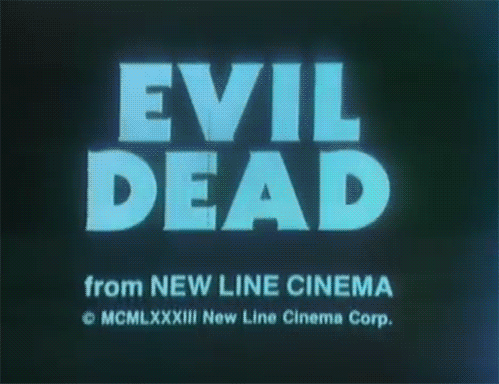
The whole series kicks off with The Evil Dead, a horror movie through and through. The acting is a bit hammy, but in this environment that works quite well and endears the audience to the series main character, Ash (played by Bruce Campbell). Raimi also establishes a directorial pattern (do not tell me if this is an actual phrase or not, I am going to run with it) in this first film that persists through the trilogy. He often films scenes and sequences predatorily. Raimi establishes this style in the opening frames of The Evil Dead by having the camera roam on its on through the forest in an aggressive fashion. The camera represents the point of view (POV) of the evil entity lurking in the forest. This action allows us to both never see the entity but fully understand the menacing and overpowering nature of its presence. It is also an excellent way to ratchet up the tension in a given scene when Raimi returns to the POV shots later in the movie. Another note about a technical aspect of this first film that remains consistent throughout the trilogy (and is especially for horror films) is the editing. Edna Ruth Paul’s work her helps cement the tone that Raimi’s camera work generates from the opening frames. She oscillates between the slow, tense moments and frenetic, fast terrifying ones without sacrificing pace or fragmenting the direction from scene to scene. The first Evil Dead also establishes a precedent that the second Evil Dead lives in – the art of the overkill. It is not overkill for overkill’s sake though, it is often for comedic effect. As their demon-possessed friend is dying a prolonged, bloody death, Ash and Scott uncomfortably stand there while the camera cuts between their grimacing faces for an overly long amount of time. This small moment actually highlights much of what makes the second film special.
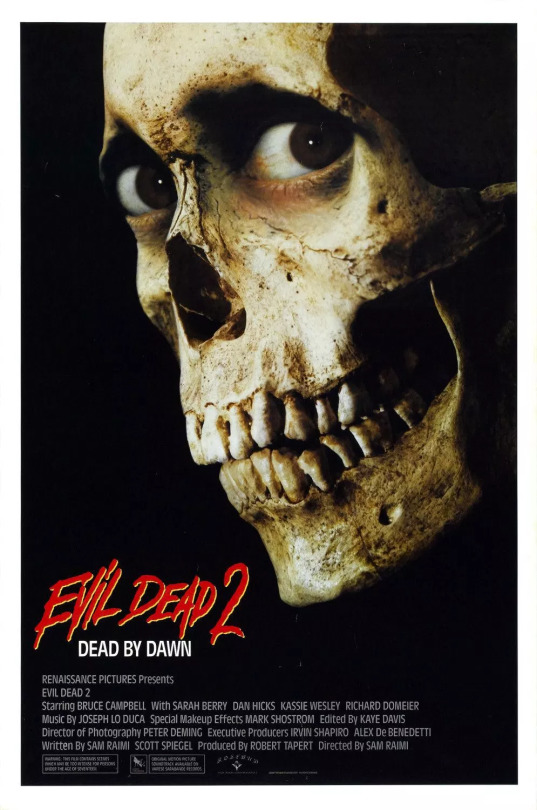
Instead of a direct sequel, Raimi decided: What if I reimagined The Evil Dead as a parody of itself? Before you start thinking that I am making this sound as though it is one of the Scary Movie films (maybe another series I will take a dive into?), you must know the whole film is not played for laughs. Evil Dead II still has elements of horror – Raimi’s predator POV surfaces once again – but it becomes a film that does not take itself too seriously. In The Evil Dead, a possessed person bites off her own hand and in Evil Dead II, Raimi has Ash hack off his own hand with a chainsaw after it becomes possessed. On its surface, that sounds ridiculous enough, but then Ash replaces that hand with the chainsaw so he can fight demons. By now, you can see where the parody kicks in. Evil Dead II is much heavier on the mythos of the universe of the series as well, which serves to give the film more depth without being indulgent or self-serious. Though the series switched editors – moving onto the work of Kaye Davis – the quality stays. Alright, I know I mentioned how editing was especially important to horror, but when you are crafting great comedy, particularly physical comedy, editing is of foremost importance. When thinking about Kaye Davis’s ability to edit to great comedic effect, I am reminded of a specific scene. Ash is beating a demon over the back of the head and the demon’s eyeball shoots across the room and lands in the mouth of a woman staring in horror. This particular scene on its surface is humorous, but the way Kaye Davis cuts between the action between Ash and the demon then this innocent woman bystander similarly divides the attention of those on screen and those watching it. While we wonder what became of the woman that is definitely choking on that eyeball, Ash still has to fight this demon. Looking back, the funniest part of the scene might be the fact that once Davis cuts away from that woman, she does not really go back. No one seems to care, including the camera, making the whole situation that much more absurd. A final note about Evil Dead II (my favorite film in the trilogy) is about Raimi’s script and direction in unison. Whereas in The Evil Dead, Bruce Campbell’s performance felt more restrained, Evil Dead II sees him come much more into his own and unleash his abilities as an actor – a trend we see fully realized in Army of Darkness.
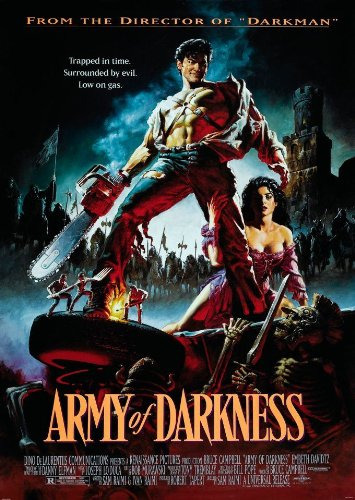
Admittedly the weakest film of the trilogy, Army of Darkness is still perhaps just as inventive and certainly as absurd as its predecessors. It is also a direct sequel to Evil Dead II, therefore picking up right when Ash gets sucked into a time warp and sent to the Middle Ages. We also find out some new information about Ash’s past as he describes working at a supermarket in modern times – again building on the mythos of the Evil Dead universe. Bruce Campbell’s comedic chops are on full display in Army of Darkness and he absolutely steals the show. Though the film still has the horror lore that comes with the series, Army of Darkness is much closer to an action comedy. When Ash and Duke Henry the Red are about to be executed and Henry tells him about the kingdom that he runs, Ash responds, “You ain’t running but jack and shit, and jack just left town.” In another scene as Ash is fighting his clone, his clone starts taunting him by saying that he is ‘bad Ash’ and Ash is ‘good Ash.’ Ash pulls out his shotgun, blows the clone away, and utters: “Good…bad…I’m the guy with the gun.” While the comedic relief of the first two films often lied in the absurdity or the undertones of the scenes, Raimi lets the jokes and barbs fly in Army of Darkness, and Bruce Campbell consistently steps up the plate and knocks each moment out of the park. I also want to note just how good some of the action filmmaking is in this film. Cutting action scenes to excess is a common trend in modern action films, but in the scene with Ash’s fight with the witch, Bob Murawski (yeah, the third editor of the trilogy) demonstrates how to cut fight scenes frequently without losing coherence or excitement. Army of Darkness also sees Ash face a single formidable foe, which was particularly interesting given it is the first time there has been a face put to the Evil Dead. The ending of Army of Darkness is not just a solid ending to a good film, but perhaps the most appropriate and fun punctuation on the series that Raimi could have imagined (I guess it turned out to be more of an ellipses though…). Ash is brought back to S-Mart, his home grocery store, left regaling others with tales of times past when a demon attacks once again. Ash must immediately snap into action and that he does. The viewers are left with the image of a triumphant Ash who has grown from normal Michigan State student in The Evil Dead to a shotgun and chainsaw-wielding fighter of demons who doubles as a store clerk in Army of Darkness.
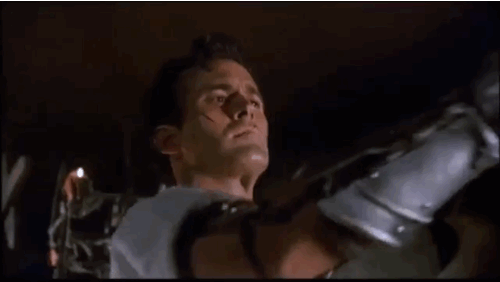
While the Evil Dead movies are not without flaws, they are exactly what I am looking for in a movie series. Raimi, Campbell, and crew refused to become complacent and make slight variations on the same movie, expanded the universe, and ultimately stayed true to what made their partnership so successful in the first place. If you are looking for a model to base your trilogy or film series on, look no further than endlessly creative and imaginative Evil Dead series.
0 notes
Text
6 Best Practices for Responsive Ads on the GDN
Over the past couple of years, Google has been shifting away from text ads on the Google Display Network for a more visual ad unit: Responsive Ads.
These units contain both a text and image component and serve almost as a bridge between the text and banner ad types. If you haven’t seen responsive text ads before, here are a few examples of what they can look like.
Text Ads used to find a large amount of inventory, but they were easy for users to overlook since there was no visual component drawing their eye. Many text ads blended seamlessly into the background of websites. Google’s shift to Responsive Ads has helped increase click through rates (CTRs) for Google Display Network ads, an improvement arguably good for advertisers and Google alike.
How Do Responsive Display Ads Perform?
Here is a small example of the performance I’m seeing for each ad unit in my accounts.
Impressions are higher as Google is increasingly preferring to use Responsive Ads to fill inventory, but on top of that, CTR for these Responsive Ads is higher than both other ad units.
Responsive Ads have also made the Google Display Network more accessible to a greater amount of advertisers. Standard banner ads have been a part of the Google Display Network for quite a while, but not all advertisers are able to take advantage of these ad slots.
There are nearly 20 standard sizes for banner ad units on the GDN, each requiring a design team to tweak, resize, and customize the visuals to make sure they look right.
Many teams simply don’t have the bandwidth to create a full suite of banner ads, not to mention regularly creating multiple sets for proper ongoing message and creative testing.
More often than not, advertisers will opt to focus on the top 5 banner sizes, causing lots of inventory to go unused on the GDN.
Enter Responsive Ads.
These ad units allow advertisers to fill every space on the Google Display Network. This includes Native, Text, and Banner ad spaces. They do this by (surprise!) being responsive to the space and showing one of many text and visual combinations available. What this means for us advertisers is that there are many things Google is doing in real time that will affect the way our ads appear:
Images will be scaled to fit into each ad unit.
Text combinations will be chosen based on available space.
Some text will be truncated in limited areas.
So knowing these things, it’s important we set ourselves up for success with any of the choices Google makes. Below are some best practices to keep in mind with images, text, and message choices while constructing Responsive Ads.
1.) Optimize for Image Scaling
Responsive Ads allow advertisers to upload a couple images with ads in a square and landscape format. This can be really great if you have images that aren’t easily cropped.
The big caveat: Although the image upload process shows the images relatively large on the screen, not all resulting ad units will have large images. Meaning, the images you upload can get scaled down to fit into the appropriate space.
We’re running ads for a luxury travel agency that plans amazing trips all across the globe. One of their more popular trips are safaris, so we’ve been running Responsive Ads to generate more interest.
When choosing our images, we leaned on their expertise and found that zebras are a customer favorite, so we decided to use zebras in the ads. We reviewed a number of images and came up with a couple that showed two different versions of zebras:
The first shows a group of zebras with a safari van in the background. Couldn’t be more spot on for what we’re advertising. The second image only shows a couple of zebras up close.
Which image do you think we used?
If you said image 2, you’re correct!
When both of these images are large, the first has a much better representation of what we’re selling, but the image of only zebras can also be eye-catching enough to those interested in zebras, even if the image isn’t perfectly on the nose for safaris.
When we scale these images down, the first becomes much harder to understand what’s going on. There are black and white stripes, and maybe a car and a tree, the ground is orange for some reason, but it’s really hard to tell what’s going on in a quick glance. In the scaled down version, the image on the right is the clear winner since it’s still clear that we’re looking at zebras.
When choosing images, think about how they look at full scale, but also how they would look if scaled down. If the images get too muddy when scaled down, you may be losing out on the impact an accompanying image can have.
2.) No Size Is Optional
Some creative sections will say they’re optional, but treat them as required. This will ensure all resulting ad variants will have the best possible representation in any space they fill.
If all else fails, use the same image, but utilize the crop tool that allows you to make a landscape image square, or vice versa.
3.) Be Flexible with Your Logo Where You Can
Brands love their logos. They’re sacred. I get that.
But for recognition on the GDN, the benefit of making small adjustments to ensure a logo is recognized can be worth the sacrifice.
The logo image uploads are the same as the image components: square and landscape. The problem is that some logos are designed to always be landscape or square and scaling can be your worst enemy here.
If you have a logo that is only square or landscape, consider adjusting to make it fit a bit better in the space, or do away with part of it to make it work better. Don’t be afraid to use only the icon portion of your logo if you need to for the square portion or shift alignment to make things fit better.
Let’s look at an example of Spotify. They have a logo that is designed for landscape with the icon on the left and the word “Spotify” to the right.
But this doesn’t fit well in the square image section of the logo for Responsive Ads. If you try and use this image in that space, it simply doesn’t fit.
At this point, you might reach out to your designer to get a square version of your logo. More often than not, the first answer a designer will give is to simply add whitespace to the top and bottom of the image to make it a square.
While this might look OK in the editor, don’t forget about the scaling effect we talked about earlier. This will likely look fine on larger ad formats, but on smaller ones it will be difficult to read.
At this point, it’s best to try and make other adjustments to get your logo in the ad in the best way possible.
For Spotify, they already have a version of their logo where they’ve adjusted to put the word “Spotify” under the icon what will work just fine for the square version.
Or they could go with just the icon by itself.
Because when the logos are scaled down to the same size, it’s easier to see and read the two we adjusted.
Although your brand managers might not like it, if you’re planning to run Responsive Ads, it’s worth it to spend some time adjusting your logo to fit both the square and landscape space without losing the feel of your brand.
4.) Be Aware of Text Combinations
In the Responsive Ads format, we’re given a number of text fields to work with.
Short Headline: 25 Characters
Long Headline: 90 Characters
Description: 90 Characters
Business Name: 25 Characters
This is much more text space than we’ve been given in the past, but it’s important to know that not all text will show up together. Furthermore, it’s important to know which text fields can and will be shown together so we can make the most of the ad impression we’re given.
Headlines will never be shown together.
This means headlines can simply be different versions of the same message. They’ll never be shown together so we don’t have to worry about repeating ourselves in the headlines.
Descriptions can be shown with either Short or Long Headlines.
This indicates descriptions can always be a further explanation of the headline. The description will never be shown without a headline, so we’ll never miss out on context. It also can be shown with either short or long headlines, so make sure you’re not repeating copy from the headlines in the description.
Sometimes headlines will show without the descriptions.
Given this fact, it can be beneficial to craft headlines that an all-encompassing of a message or are enticing enough to get a user to click through to learn more without the aid of the description. For me, this means that I’ll try to include a call to action in my long headlines if possible.
Both Long Headline and Description can end in ellipses if they don’t fit the space.
Since these text fields can be truncated, it’s important to front-load messaging. Make sure users will get all information at the front of the text so nothing is missed if the end is cut off.
Once we know the text field combinations, it’s much easier to craft copy that’s informative, consistent, and non-repetitive.
5.) Check & Share Previews
Although Responsive Ads are created in real time and there are nearly 1 billion combinations of a single ad that could be created, we do get a small glimpse into what these ads might look like with previews.
During the build process, there are a series of sections that will show us what our ads might look like in the wild. But these are mostly limited to square versions and one mobile-friendly view.
The best place to view the potential final products is actually after the ad has been created. When in the Google Ads interface, you can click on the ad itself, and it will bring up a Preview box. Within that box, there’s a link. This is where the real magic happens.
This link opens up a whole new window with many more previews of the potential ad combinations for Native, Image, and Text placement.
Granted, this isn’t nearly a comprehensive list of the combinations that can be created, but this is much better than what we’ve been given to this point. Better yet, this link is sharable so other members of the team (designers, client contacts, bosses, brand managers, etc.) can see the potential ad units and give any feedback.
6.) Be Cautious of Brand Safety and Regulations
After all of this, Responsive Ads simply aren’t right for all companies. And that’s OK.
From a brand safety perspective, it’s sometimes unacceptable for a company to not know what all combinations of images and text are going to show up. They would rather control all aspects of the ads from start to finish, which means banner ads are going to be the best way forward for them on the Google Display Network.
Another common issue with Responsive Ads deals with regulations. Some industries require advertisers to disclose legal information directly in their ads, which for Responsive Ads would mean they would likely have to use nearly all text and image space to cover those legal requirements without getting to the actual advertisement itself.
Keep these regulations in mind when looking through the combinations of text fields and images. If you’re able to cover your bases, then you’re all set. If not, this might not be the ad unit for you.
Closing thoughts
And there you have it! Responsive Ads on the GDN don’t require a physics degree, but there are certainly some steps you can take to step up your game without too much effort. Choose images and text wisely, understand how they’ll play together, and make sure you’ve covered your regulatory bases before jumping in.
Have you been running Responsive Ads on the GDN? What has been your experience? Have you had any issues with the best practices mentioned above?
Article Source
from https://www.imapplied.co.za/uncategorized/6-best-practices-for-responsive-ads-on-the-gdn/
0 notes
Text
8 Advanced Twitter Tips For Bloggers
Twitter hacks to the max: Imagine getting some insights into how to grow a Twitter account beyond the basics. Here are 8 advanced Twitter tips to start using right away.
Twitter Advanced Search
When you want to search Twitter beyond the basics, try the Twitter Advanced Search. Once you get to Twitter’s advanced search results page, there are various options to filter results by profiles, media type, and others.
Consider using advanced search for blog topics. This is one of my favorite research tools to see what folks are tweeting about when it comes to a particular topic. Here’s an example:
Glean and Clean a Twitter Feed
In conjunction with Twitter lists, Twitter’s advanced search allows for tweet filtering from only people you follow. If you have thousands of followers, it gets hard to keep up with everyone and who is saying what. Here’s a search I did on people I follow talking about dog shampoo:
Once you narrow the advanced search results down, just pop over to the left side of your screen and filter by folks you follow.
Monitor Brand/Blog Mentions on Twitter
The folks at Zapier turned us on to a cool tip for a more focused Twitter monitoring experience: “Though it seems like it’d only take a simple search of your company’s name, monitoring your brand on Twitter is more effective with the site’s Advanced Search. In addition to looking for mentions of your company’s Twitter handle, create a search query that includes your URL, name and, possibly, common misspellings.”
Here’s how to do it using BlogPaws as an example:
Twitter Analytics as Your BFF
Your Twitter Analytics dashboard is where every single one of your tweet metrics can be found. In addition to Google Analytics, using Twitter Analytics can provide a robust monthly view of your social media plans in action.
See which tweets your audience engages with most, get to know your followers and their demographics, and much more. Hubspot does a fantastic job outlining ways to glean data from Twitter Analytics.
Paid Twitter Promotions
Included in Twitter Analytics is access to how paid ads perform, so use this feature. An overview of both organic and tweet performance is included. You can even export data from the Twitter API as a CSV file.
Promoted tweets are the same as ordinary tweets except that you put money behind them to reach a wider range of people, engage target audiences, etc. The tweets function the same way except they are labeled as promoted.
Pin + Tweet
Pin your favorite tweet! Anyone can pin a tweet high atop their profile so that it stays there until you unpin it. It’s advanced because not a lot of folks know about it. When you know, you can use it. Find your tweet, click the ellipses, and select pin to your profile page. To unpin that tweet, click on the more button again and choose ‘Unpin from profile page’.
Try 4 Photos in a Tweet
You can tag people, keep 140 characters, and also upload up to four images per Tweet. This technique works beautifully for product reviews, a variety of pet poses, and more.
Twitter List Searching
Major hat tip to PostPlanner for sharing this advanced Twitter tip: They say, “Would your prospecting be easier if you could search for Twitter lists?”
To search for Twitter lists from your browser, use this string:
site:twitter.com inurl:lists <your search term>
Let’s say you are exhibiting at a pet craft fair in Sacramento, California. Find folks on Twitter who care about pet crafts in the area. Woot!
Bonus Fun Tip: Love stickers? (Admit it, you do). Snapchat and Instagram have stickers, Facebook too, and now Twitter lets you add stickers to tweets for fun, flavor, and personality.
Compose a tweet, tap the camera button, then the sticker *smiley* icon, tap the sticker, drag it over, and pinch/stretch/turn the sticker as you want.
What tips did we miss? Let us know in the comments below.
Carol Bryant is the Marketing and Social Media Manager for BlogPaws and runs her own dog blog, Fidose of Reality and its fundraising arm, Wigglebutt Warriors. When not busy playing with her Cocker Spaniel, Dexter, she stays far away from cooking. Her trademark is her mantra and is tattooed on her arm: My Heart Beats Dog.®
Images: By George Rudy / Ilya Yamshchikov /Shutterstock.com
The post 8 Advanced Twitter Tips For Bloggers appeared first on BlogPaws.
from News And Updates About Pets http://blogpaws.com/executive-blog/blogging-social-media-info/social-media-strategy/8-advanced-twitter-tips-for-bloggers/
0 notes